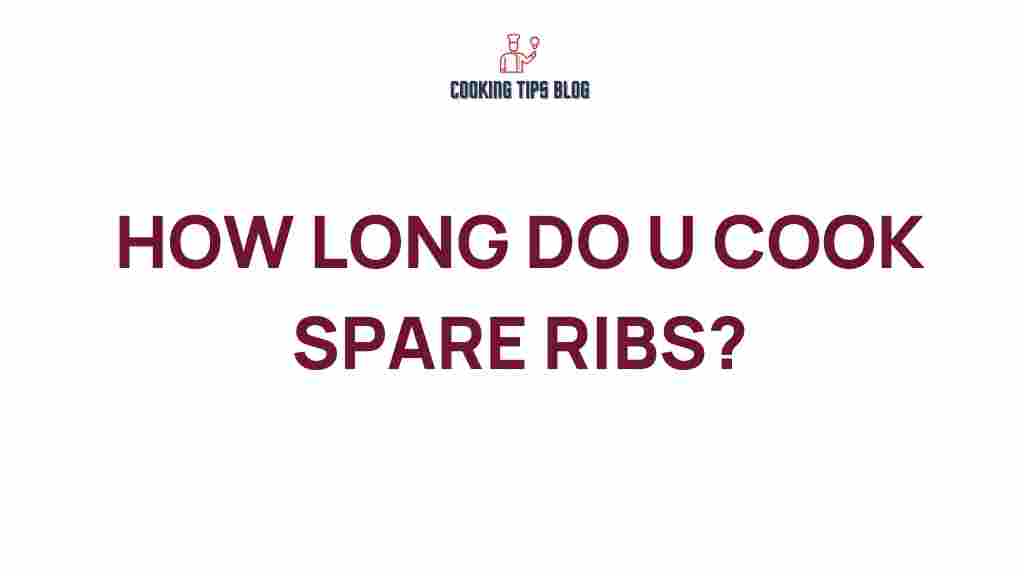Mastering Spare Ribs: The Secret to Perfectly Cooked Delicacies
Spare ribs are one of the most beloved cuts of meat, known for their rich flavor and tender texture. Whether you’re grilling, smoking, or baking, mastering the art of cooking spare ribs can elevate your culinary skills and impress your family and friends. In this article, we will explore the secrets to perfectly cooked spare ribs, from preparation to cooking techniques, troubleshooting common issues, and serving suggestions.
Understanding Spare Ribs
Before diving into cooking methods, it’s essential to understand what spare ribs are. Spare ribs are cut from the lower part of the pig’s ribcage and are known for their meatiness and flavor. They contain both bones and meat, making them perfect for slow-cooking methods that allow the fat to render and the meat to become tender.
Types of Spare Ribs
There are several types of spare ribs available:
- St. Louis Style Ribs: These are trimmed spare ribs with the sternum, cartilage, and rib tips removed, resulting in a more rectangular shape that cooks evenly.
- Baby Back Ribs: While technically not spare ribs, baby back ribs are smaller and more tender, making them a popular choice for quick cooking.
- Full Spare Ribs: These include the entire rib section and have more meat and fat, providing a richer flavor.
Preparing Spare Ribs
Proper preparation is crucial when it comes to spare ribs. Here’s a step-by-step guide to get you started:
Step 1: Choosing the Right Ribs
When selecting spare ribs, look for a good amount of meat on the bones with a decent layer of fat. This fat will render during cooking and keep the meat moist and flavorful.
Step 2: Trimming the Ribs
If you have full spare ribs, consider trimming them to a St. Louis style. Use a sharp knife to remove any excess fat or cartilage. This not only improves presentation but also helps the ribs cook more evenly.
Step 3: Removing the Membrane
One critical step that many overlook is removing the membrane on the back of the ribs. This tough layer can prevent seasonings from penetrating and can result in chewy meat. To remove it:
- Use a knife to lift a corner of the membrane.
- Grab it with a paper towel for a better grip.
- Pull it off slowly and steadily.
Seasoning Your Spare Ribs
Seasoning is where you can get creative. Here are some popular options:
- Dry Rub: A mix of brown sugar, paprika, garlic powder, onion powder, salt, and pepper creates a flavorful crust.
- Marinade: A marinade can add depth. Consider using soy sauce, apple cider vinegar, and honey for a sweet and tangy flavor.
- Barbecue Sauce: Brush your favorite barbecue sauce on the ribs during the last few minutes of cooking for a sticky glaze.
Cooking Methods for Spare Ribs
Once your spare ribs are prepped and seasoned, it’s time to cook them. Here are the most popular methods:
Grilling Spare Ribs
Grilling is a fantastic way to achieve that smoky flavor. Here’s how to do it:
- Preheat your grill to medium heat.
- Place the ribs bone-side down on the grill.
- Cook for about 3-4 hours, turning occasionally and basting with barbecue sauce during the last 30 minutes.
Smoking Spare Ribs
Smoking spare ribs infuses them with a rich flavor. Follow these steps:
- Preheat your smoker to 225°F (107°C).
- Place the ribs on the smoker rack and smoke for 5-6 hours, spritzing with apple juice every hour.
- Wrap the ribs in foil for the last hour to enhance tenderness.
Baking Spare Ribs
If you prefer an indoor method, baking is a great option:
- Preheat your oven to 300°F (149°C).
- Place the ribs in a baking dish and cover tightly with foil.
- Bake for 2.5-3 hours, then uncover and brush with barbecue sauce.
- Broil for an additional 5 minutes to caramelize the sauce.
Troubleshooting Common Issues with Spare Ribs
Even the best cooks can face challenges. Here are some common issues and how to fix them:
Issue 1: Ribs are Tough
If your spare ribs come out tough, it’s likely due to not cooking them long enough. Ensure you allow enough time for the collagen in the meat to break down. Cooking at a low temperature for a more extended period can help.
Issue 2: Ribs are Dry
Dry ribs usually result from overcooking. To prevent this, monitor the cooking time closely and use a meat thermometer to check for doneness. Aim for an internal temperature of 190°F (88°C) for optimal tenderness.
Issue 3: Ribs Lack Flavor
If your ribs are bland, consider adjusting your seasoning or marinade. Allowing the ribs to marinate overnight can enhance the flavor significantly. Additionally, using a dry rub before cooking can help create a flavorful crust.
Serving Spare Ribs
Once you have perfectly cooked spare ribs, it’s time to serve them up. Here are some ideas for sides and presentations:
- Classic Sides: Serve with coleslaw, baked beans, or corn on the cob for a traditional barbecue experience.
- Creative Twists: Pair with grilled vegetables or a fresh salad for a lighter meal.
- Garnishing: Sprinkle chopped parsley or green onions on top for a pop of color.
Conclusion
Mastering spare ribs can transform your cooking game and provide your loved ones with a delightful dining experience. By understanding the different types of ribs, preparing them correctly, and utilizing various cooking methods, you can achieve perfectly cooked spare ribs every time. Remember to troubleshoot any issues that arise and get creative with your seasoning and serving options. Your journey to becoming a spare rib expert starts now!
For more delicious recipes and tips, check out our recipe blog and stay updated on the latest culinary trends. For additional insights on grilling techniques, visit this resource.
This article is in the category Recipes and created by Cookingtipsblog Team
